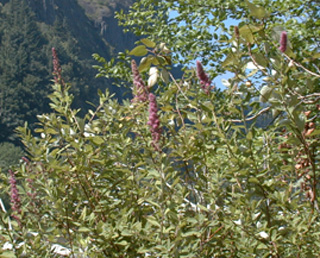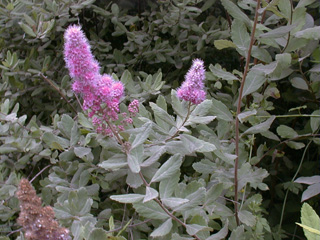

General Species Description
- An erect, deciduous, native shrub. Grows up to 2.5 meters tall. The stems are woody, brittle, brown to purple-brown, slender, and branch easily. Species can become so numerous as to be impenetrable.
Leaves
- The leaves of the Spiraea douglasii are alternate, oval to oblong, 3-10 cm long, with the lower ½ of the leaf margin entire and the upper ½ of the leaf margin serrated. The upper leaf is a dark green, while the under side is a pale green either with small fine hairs or hairless. The leaves can vary widely in both shape and size.
Inflorescence/Flowers
- Clustered, dense, terminal, upright, plume-like panicles. Panicles are oblong to conical and 6-20 cm long. Each flower has five tiny petals, pale to deep pinkish rose in color, approximately 5 mm across. The flowers have many red stamens extending beyond the petals resulting in a hairy appearance. The flowers will dry to a brown after only a day or two. Spiraea douglasii blooms from July to August.
Fruits
- Small, smooth pod-like follicles, clustered. The fruit remains on the stem after the leaves have fallen.
Habitat
- Spiraea douglasii can be found along stream banks, roadside ditches, lakeshores, swamps, bogs, and fens. Low to mid elevations. Can tolerate extended periods of flooding, but not shade. Generally associated with Juncus effusus (soft rush), typha latifolia (broad leaf cattails), and Gaultheria shallon (salal).
Range
- This species can be bound along the coast and inland from Southern Alaska to Northern California, North and Central Idaho, and Northeastern Oregon.
Similar Species
- Appears similar to Rubus Spectabilis (Salmonberry) during the winter, except for the peeling bark, rust-red color, prickles, and lack of nodes, and the Symphoricarpos albus (Snowberry), although it has opposite leaves and narrower twigs. From afar, can be mistaken for Epilobium angustifolium (Fireweed) or Lythrum spp. (Loosestrife), but easily distinguishable up close as flowers are more dense on the Spiraea douglasii.
Ecological Value
- Spiraea douglasii can form dense thickets serving as escape habitat for certain wildlife species and as a barrier to wetlands by humans or livestock. Birds and small mammals feed on the plant's seeds; large herbivores feed on the twigs and leaves. This species can prevent the survival of other native species.
Human Value
- Used as an ornamental shrub in landscaping. Used by the Nuu-chah-nulth as broom-like implements for collecting tubular marine dentalia shells, which were used as currency among northwest coast peoples.
References
- Pojar, J. and MacKinnon, A., Plants of the Pacific Northwest Coast, 1994. Cooke, S.S., A Field Guide to the Common Wetland Plants of Western Washington and Northwestern Oregon, 1997. Guard, B. J., Wetland Plants of Oregon and Washington, 1995. /DD>
This page was created by: Michelle Michaud, August 1999
Return to Northwest Oregon Wetland Plants Project